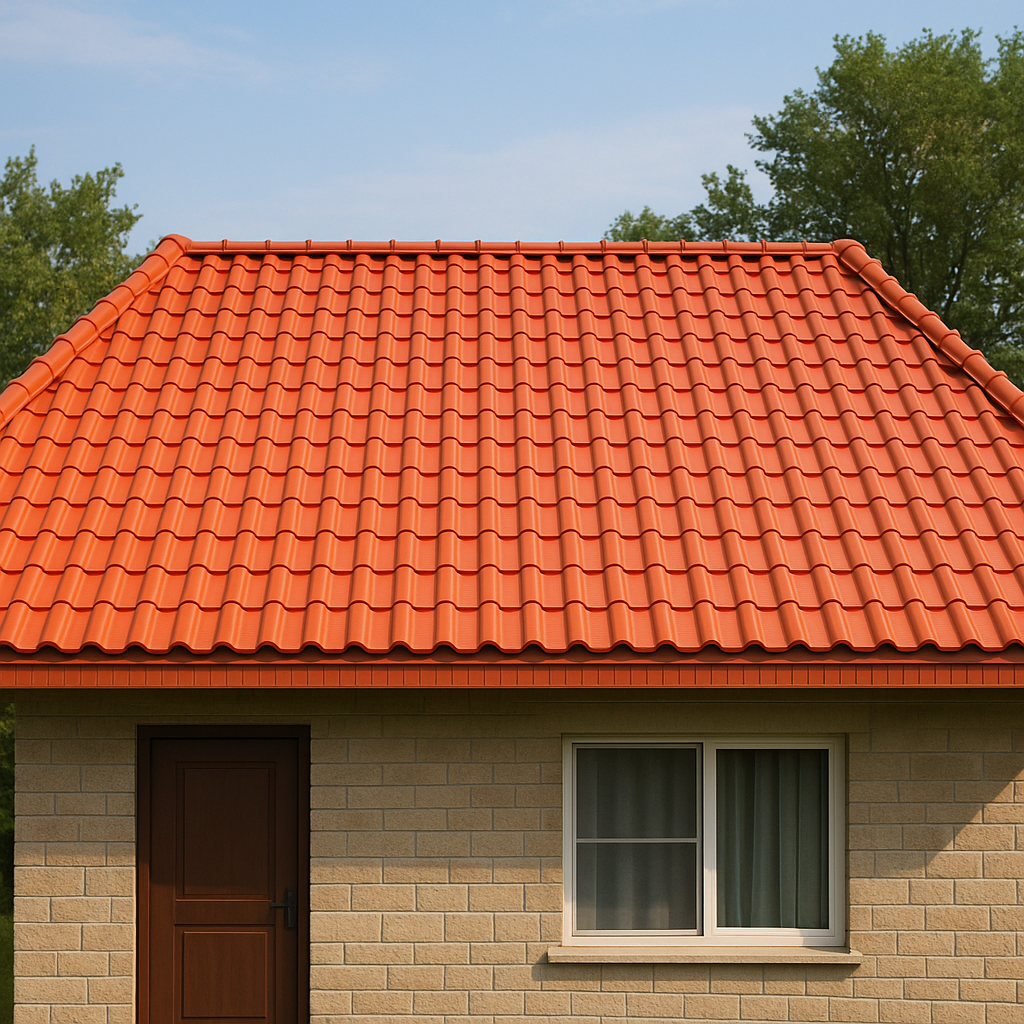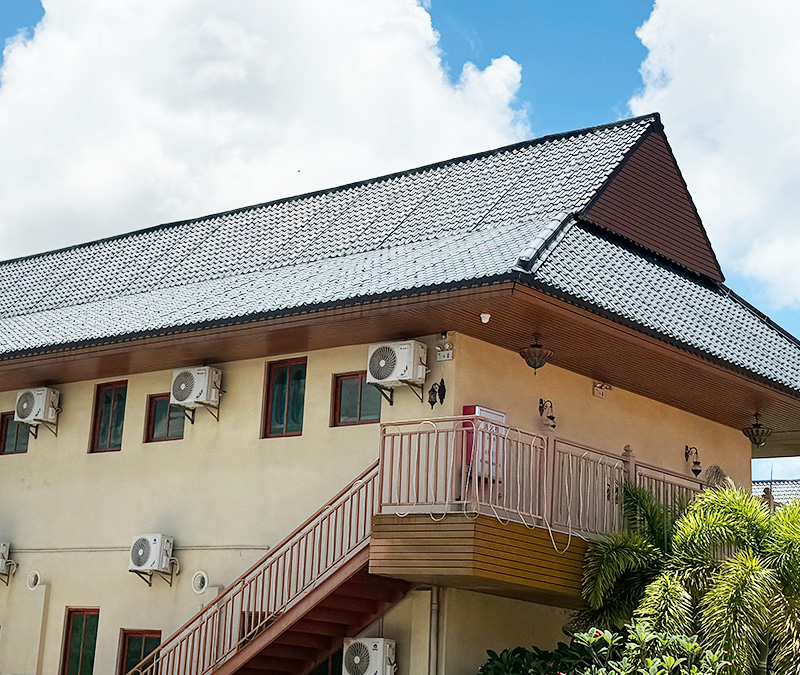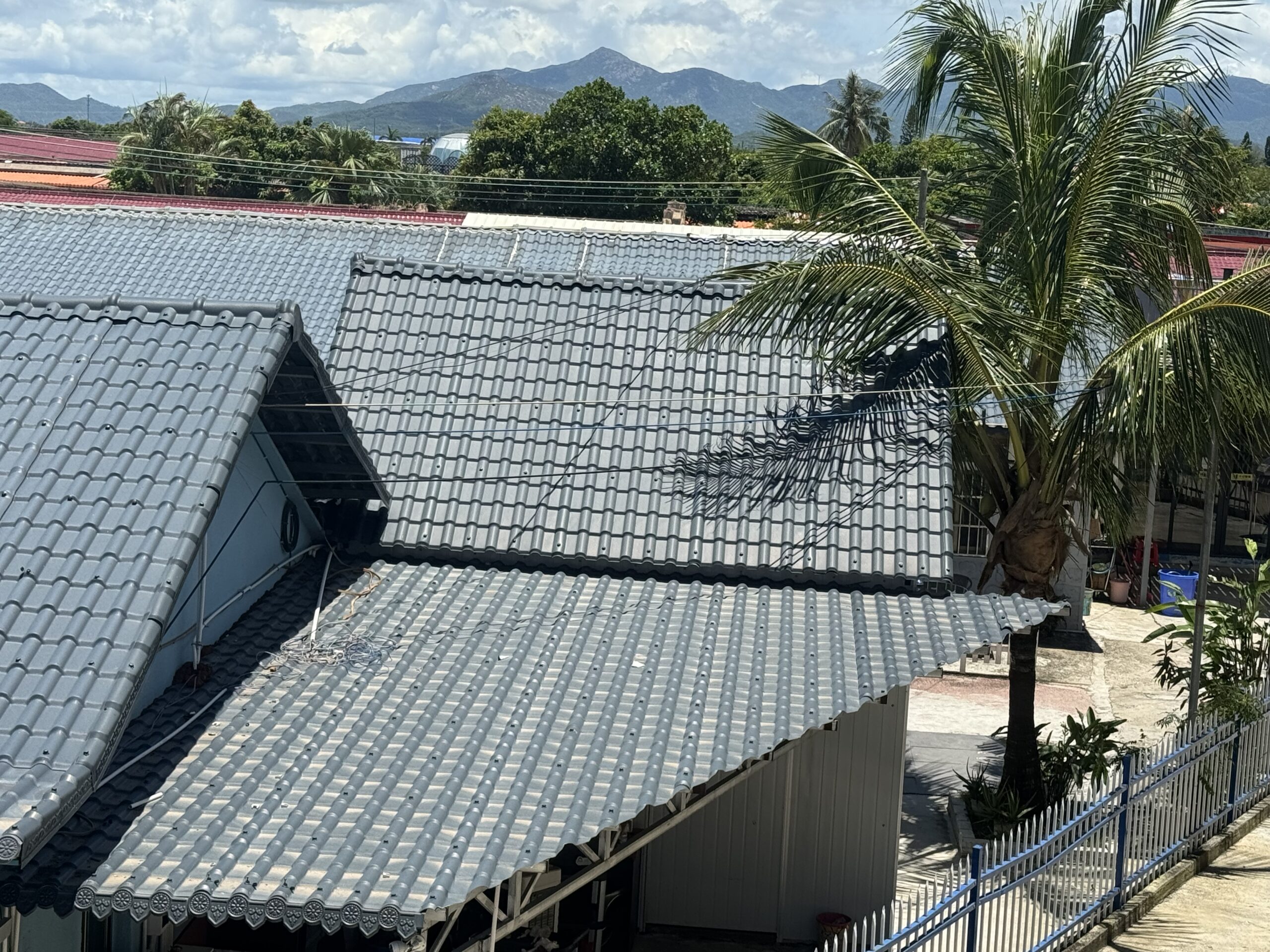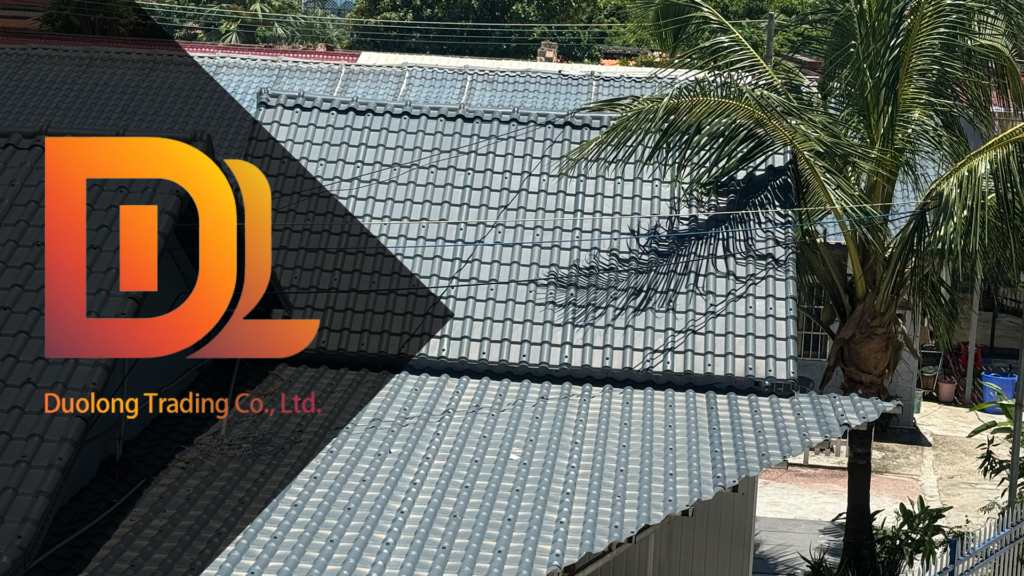In Southeast Asia’s hot, humid, and UV-intense environment, choosing the right roofing material is about much more than just the initial price. Many building material wholesalers and construction contractors focus solely on unit price when sourcing roofing products, overlooking the long-term costs tied to maintenance, replacements, and performance degradation over time.
When comparing resin roof tiles vs metal roofing sheets, the latter often appears to be the “cheaper” option. But in reality, the constant issues—rusting, leakage, repairs—quickly escalate total cost of ownership. Worse, these problems may delay project delivery and erode trust with clients.
Through long-term partnerships with buyers in Vietnam, Thailand, and Malaysia, we’ve seen a growing trend: professional importers and wholesalers are shifting toward ASA weatherproof resin tiles, attracted by their superior durability and long lifespan. The true cost of a roofing solution isn’t what you pay upfront—it’s what you invest throughout its entire lifecycle.
This article provides a detailed, data-backed comparison of both materials under Southeast Asian climate conditions—so you can decide: is cheap really cost-effective?
Cheap Now or Cost-Effective Later? A True Comparison of Roofing Total Cost of Ownership
In roofing material procurement, “lowest price” often dominates decision-making—especially for cost-sensitive projects. However, the real expense of a roofing product is not just the upfront purchase price. It lies in how often it needs to be replaced, how frequently it requires maintenance, and whether it causes delays or additional labor costs due to premature failure.
Let’s take a 1,000㎡ roofing area as an example. Using standard metal roofing sheets, rusting, peeling paint, and leakage problems typically occur around the 5-year mark. This often results in full or partial roof replacement, plus added repair labor and construction delays. Over a 10-year period, the cumulative maintenance and replacement costs can exceed the original purchase cost.
By contrast, high-durability ASA resin roof tiles—like those produced by Duolong—have an average service life of 10–15 years, with minimal maintenance required. Although the initial unit cost may be slightly higher than metal roofing, the long-term savings are substantial.
From customer cases in the Philippines, Malaysia, and Vietnam, we’ve found that buyers who initially chose metal sheets often spent over 50% of their original budget on repairs within just 5 years. In contrast, customers using Duolong ASA resin tiles reported negligible maintenance costs over a full decade.
What’s more, the consistent performance of resin tiles helps contractors avoid project delays and customer complaints—preventing brand damage and disputes that carry hidden costs no price tag can show.

Tropical Test: Which Roofing Material Truly Withstands Moisture and Salt Air?
For many coastal countries across Southeast Asia and the Middle East, one of the toughest challenges in roofing is the unforgiving climate. While metal roofing sheets may seem cost-effective at first, they have a major weakness: they are highly susceptible to corrosion in humid, high-salinity environments. In cities like Cebu (Philippines), Da Nang (Vietnam), and Penang (Malaysia), contractors often report widespread rusting and even perforation in steel roofs within just 3 to 5 years.
In contrast, ASA synthetic resin roof tiles are specifically engineered for tropical and subtropical conditions. Their formulation includes UV stabilizers and corrosion-resistant compounds, making them ideal for high humidity and coastal exposure. These tiles offer excellent resistance to oxidation, acid, and alkaline substances. Even under prolonged sunlight and heavy rainfall, they retain their color and structural integrity.
At Duolong, we’ve conducted field trials in real project sites—including Ho Chi Minh City, Medan, and Chonburi—where our ASA resin tiles have endured over six years of exposure without noticeable fading or degradation. For coastal contractors and material importers, this long-term durability translates into lower maintenance costs and fewer customer complaints.
If your project is located in a high-humidity, high-UV, or coastal region, choosing resin roofing is not just a weatherproof solution—it’s a smart investment in long-term quality and brand reputation.
When Maintenance Eats Your Budget: Labor Costs Matter More Than You Think
For many contractors and material distributors, the price of roofing materials is only part of the cost equation. The real budget drain often comes from ongoing maintenance and labor costs—and metal roofing is a key culprit.
Due to its low resistance to oxidation, metal roof sheets frequently rust and leak, especially in humid or coastal climates. Once leakage occurs, repairs often involve not just replacing the damaged section but also re-securing surrounding panels. These tasks are labor-intensive and increasingly expensive in Southeast Asian markets like Malaysia, Thailand, and the Philippines, where construction labor costs are rising steadily.
In contrast, ASA resin tiles offer near-zero maintenance after installation. Their high durability, impact resistance, and UV stability prevent common problems like cracking, corrosion, and deformation. According to customer feedback from Duolong projects in Ho Chi Minh City and Manila, over 80% of users reported no maintenance work at all within the first five years—while users of metal roofing required 2–3 patch repairs in the same period.
Furthermore, resin tiles are lightweight and easy to install. This translates to faster construction times, reduced labor dependency, and minimized rework risks. In regions where labor costs are climbing, resin roofing isn’t just a product advantage—it’s a cost control strategy.

More Square Meters per Container: The Hidden Transport Advantage of Resin Roofing
For bulk material importers, regional trade companies, and overseas construction projects, cross-border transportation and storage costs often outweigh the importance of unit product pricing.
Metal roofing sheets, due to their heavy weight and non-stackable shapes, utilize container space inefficiently. In practical scenarios, a 20-foot container typically holds only about 500–600㎡ of metal roofing. In contrast, ASA resin roof tiles are lightweight, compressible, and resistant to deformation, allowing over 1,000㎡ to fit into the same space—nearly double the transport efficiency.
This translates directly to lower freight cost per square meter. Additionally, resin tiles are more durable during loading and transit, reducing the risk of breakage or warping. Their resistance to moisture and oxidation also minimizes packaging requirements, further cutting down preparation costs for export.
According to Duolong’s import partners in Vietnam and the Philippines, logistics savings from full-container resin tile shipments reach up to 15–20% compared to metal sheets. This efficiency makes resin roofing a preferred option for retail wholesalers and project contractors handling large-scale orders.
For Chinese exporters and OEM producers, a product’s transportation adaptability and container loadability are fast becoming decisive factors in international competitiveness.
When Certification Becomes a Gatekeeper: Resin vs Metal Roofing in Project Compliance
For government tenders, international contracts, or large-scale construction projects, product certification is not optional—it’s a non-negotiable entry requirement. Certifications like CE and ISO are more than badges of quality; they signify compliance with international benchmarks in safety, durability, and environmental responsibility.
ASA synthetic resin roof tiles, like those produced by Duolong, are highly certifiable. They are regularly issued CE conformity, ISO9001 quality assurance, and SGS environmental testing reports. Over 70% of our large-scale exports to countries such as Vietnam, Indonesia, and Nigeria are designated for projects that demand third-party compliance proof—public schools, healthcare centers, and municipal facilities being prime examples.
In contrast, metal roofing often fails to meet environmental and technical standards related to VOC emissions, corrosion resistance, and material safety. As a result, it is frequently disqualified from government procurements, international development projects, and environmentally sensitive applications. Several contractors we’ve worked with have experienced costly material swaps midway through implementation due to failed certifications.
Choosing a roofing product that meets international compliance standards is no longer just a technical detail—it’s a strategic safeguard. Duolong’s certified ASA resin tiles are engineered to meet the stringent needs of institutional buyers, giving you peace of mind during tenders and long-term supply chain planning.

Low Price Isn’t Always the Best Deal—The Smarter Investment Lies in a Roof That Lasts a Decade
In Southeast Asia and the Middle East, smart construction material procurement is about more than just who offers the lowest unit cost. While metal roofing sheets may seem budget-friendly at first, their hidden lifecycle costs—corrosion, frequent repairs, poor transport efficiency, and limited certification—start to emerge over 5 to 10 years. These lead to project delays, inflated budgets, and customer dissatisfaction.
In contrast, ASA resin tiles consistently outperform in every meaningful category:
- Longer lifespan—often exceeding 10 years without replacement
- UV and corrosion resistance—built for tropical, coastal environments
- Maintenance-free installation—lower long-term labor costs
- Lightweight and stackable—logistics-friendly for cross-border trade
- Full certifications—eligible for government and international projects
At Duolong, we don’t just manufacture—we understand the real-world demands of international buyers. That’s why we offer project-specific suitability reports and free cost comparison estimates to help you make informed, profitable decisions.
Get in touch with Duolong today and make a roofing investment that truly pays off.


